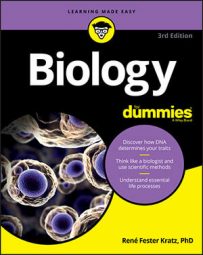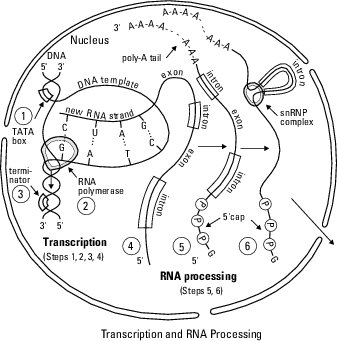When your cells need to build a particular protein, the enzyme RNA polymerase locates the gene for that protein and makes an RNA copy of it. Because RNA and DNA are similar molecules, they can attach to each other just like the two strands of the DNA double helix do. RNA polymerase slides along the gene, matching RNA nucleotides to the DNA nucleotides in the gene.
The base-pairing rules for matching RNA and DNA nucleotides are almost the same as those for matching DNA with DNA. The exception is that RNA contains nucleotides with uracil (U) rather than thymine (T). During transcription, RNA polymerase pairs C with G, G with C, A with T, and U with A. (that the new RNA strand CUAG pairs up with the DNA sequence GATC in the gene
It may seem strange that your cells copy the information in your genes into a sort of mirror image made of RNA, but it actually makes a lot of sense. Your genes are extremely important and need to be protected, so they’re kept safe in the nucleus at all times. Your cells make copies of any information they need so the original DNA doesn’t get damaged.You can think of your chromosomes like drawers in a file cabinet. When your cells need information from the files, they open a drawer, take out a file (the gene), and make a copy of the information (the RNA molecule) that can travel out into the world (the cytoplasm). The original blueprint (the DNA) is kept safely locked away in the file cabinet.
Of course, RNA polymerase and DNA aren’t the only things involved in transcription. Keep reading to find out more.Finding out what else is involved with transcription
RNA polymerase locates the genes it needs to copy with the help of proteins called transcription factors. These proteins look for certain sequences in the DNA that mark the beginnings of genes; these sequences are called promoters.Transcription factors find the genes for the proteins the cell needs to make and bind to the promoters so RNA polymerase can attach and copy the gene. Many promoters contain a particular sequence called the TATA box because it contains alternating T and A nucleotides. Transcription factors bind to the TATA box first, followed by RNA polymerase.
The ends of genes are marked by a special sequence called the transcription terminator. Transcription terminators can work in different ways, but they all stop transcription.
Walking through the transcription process
As you can see from the following, the process of transcription is pretty straightforward:- RNA polymerase binds to the promoter with the help of transcription factors.
By binding to the promoter, RNA polymerase gets set up on the DNA so it’s pointed in the right direction to copy the gene.
- RNA polymerase separates the two strands of the DNA double helix in a small area.
By opening the DNA, RNA polymerase can use one of the DNA strands as its pattern for building the new RNA molecule. (The strand of DNA that’s being used as a pattern is labeled as the DNA template. The new RNA strand is shown as it’s being built against the template strand.)
As RNA polymerase slides along the DNA, it opens a new area, and the DNA behind it closes back up.
- RNA polymerase uses base-pairing rules to build an RNA strand that’s complementary to the DNA in the template strand.
Because the base-pairing rules are specific, the new RNA molecule contains a mirror image of the code in the DNA.
- RNA polymerase reaches the termination sequence and releases the DNA.
Some terminators have a sequence that causes the new RNA to fold up on itself at the end, making a little bump that causes RNA polymerase to get knocked off of the DNA.
Your cells use transcription to make several types of RNA molecules. Some of these RNA molecules are worker molecules for the cell, others are part of cellular structures, and one type — mRNA — carries the code for proteins to the cytoplasm.


